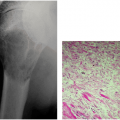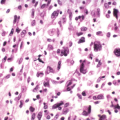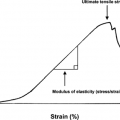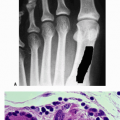Evaluation of Soft Tissue Tumors
Carol D. Morris
Soft tissue tumors are heterogeneous in their behavior and management. The vast majority of soft tissue tumors are benign, with benign tumors outnumbering malignant tumors by a factor of at least 100. This chapter deals with the general diagnostic and management guidelines for both benign and malignant soft tissue tumors. More specific information is available in each tumor-specific chapter.
Pathogenesis
Etiology
The etiology of most soft tissue tumors is largely unknown. Environmental exposures, radiation, viral infection, and genetic associations have all been implicated, though the developmental associations are casual in most instances (Box 2-1).
Epidemiology
Benign
True incidence is poorly reported
∼300/100,000
Outnumber malignant soft tissue sarcomas by 100:1
Malignant
∼8,700 cases/year in the U.S.
Annual incidence ∼1.5/100,000
8/100,000 in individuals >80 years old
Accounts for <1% of all cancers
Pathophysiology
While the pathophysiology of most soft tissue tumors remains ambiguous, the past two decades have provided considerable insight into the biology of these tumors in the form of cytogenetic and molecular information. Chromosomal translocations or other chromosomal aberrations have been reported for virtually every type of soft tissue tumor. The more consistent genetic findings are outlined in Tables 2-1 and 2-2. In addition, a number of inherited conditions are associated with the development of soft tissue tumors (Table 2-3).
Classification
Soft tissue tumors are most commonly characterized histologically according to the type of tissue they most closely resemble. The most widely recognized classification is that
of the World Health Organization (WHO), which was first published in 1969 and most recently updated in 2002.
of the World Health Organization (WHO), which was first published in 1969 and most recently updated in 2002.
Table 2.1 Cytogenetic and Molecular Genetic Alterations Seen in Benign Soft Tissue Tumors | ||||||||||
|---|---|---|---|---|---|---|---|---|---|---|
|
Box 2-1 Etiologic Factors Reported in the Development of Soft Tissue Tumors
|
The major histologic categories are:
Adipocytic
Fibroblastic
Fibrohistiocytic
Smooth muscle
Perivascular
Skeletal muscle
Vascular
Chondro-osseous
Uncertain differentiation
The major histologic categories are then divided into benign, intermediate, and malignant groups. WHO recognizes over 60 subtypes of benign soft tissue tumors and over 50 subtypes of malignant soft tissue tumors (sarcomas). It is not thought that the malignant subtypes arise from the benign forms. For example, liposarcoma does not arise from benign fat in lipoma but rather histologically exhibits lipoblastic differentiation.
Diagnosis
Benign soft tissue tumors are fairly common and rarely problematic. In contrast, soft tissue sarcomas are exceedingly rare but diagnostically and therapeutically challenging. Unfortunately both benign soft tissue tumors and soft tissue sarcomas have a deceptively similar presentation, and as such a delay in the diagnosis of soft tissue sarcoma is not uncommon (Table 2-4). While clinical and imaging features will help guide an appropriate work-up, any suspicious soft tissue mass must be biopsied.
Table 2.2 Cytogenetic and Molecular Genetic Alterations Seen in Malignant Soft Tissue Tumors | ||||||||||||||||||||||||||||||
|---|---|---|---|---|---|---|---|---|---|---|---|---|---|---|---|---|---|---|---|---|---|---|---|---|---|---|---|---|---|---|
| ||||||||||||||||||||||||||||||
Table 2.3 Inherited Syndromes Associated with Soft Tissue Tumors | ||||||||||||||||||||||||||||||
|---|---|---|---|---|---|---|---|---|---|---|---|---|---|---|---|---|---|---|---|---|---|---|---|---|---|---|---|---|---|---|
|
Physical Examination and History
Clinical Features
History
How long has the mass been present?
Masses present for long periods of time are most likely benign.
New masses arising over a short period of time raise malignancy suspicion.
Synovial sarcoma and clear cell sarcoma are classic exceptions (may be present for many years).
Any mass that persists for >4 weeks in the absence of clear-cut trauma warrants consideration of biopsy.
Table 2.4 Guidelines for the Clinical Presentation of Extremity Soft Tissue Masses
Parameter
Benign
Malignant
Comments
Pain
Rare*
Rare
Uncommon in the absence of nerve or bone invasion
Size
<5 cm
>5 cm
Location
Superficial (subcutaneous)
Deep to fascia
1/3 of soft tissue sarcomas are superficial.
Mobility
Mobile**
Fixed
Consistency
Soft
Firm
Growth
Stable
Enlarging
Synovial sarcoma and clear cell sarcoma can be very slow-growing.
* One benign soft tissue mass that typically presents with pain is an intramuscular hemangioma.
** Benign peripheral nerve sheath tumors are tethered to the nerve and therefore are mobile only medially and laterally but not proximally/distally.
Stay updated, free articles. Join our Telegram channel

Full access? Get Clinical Tree








